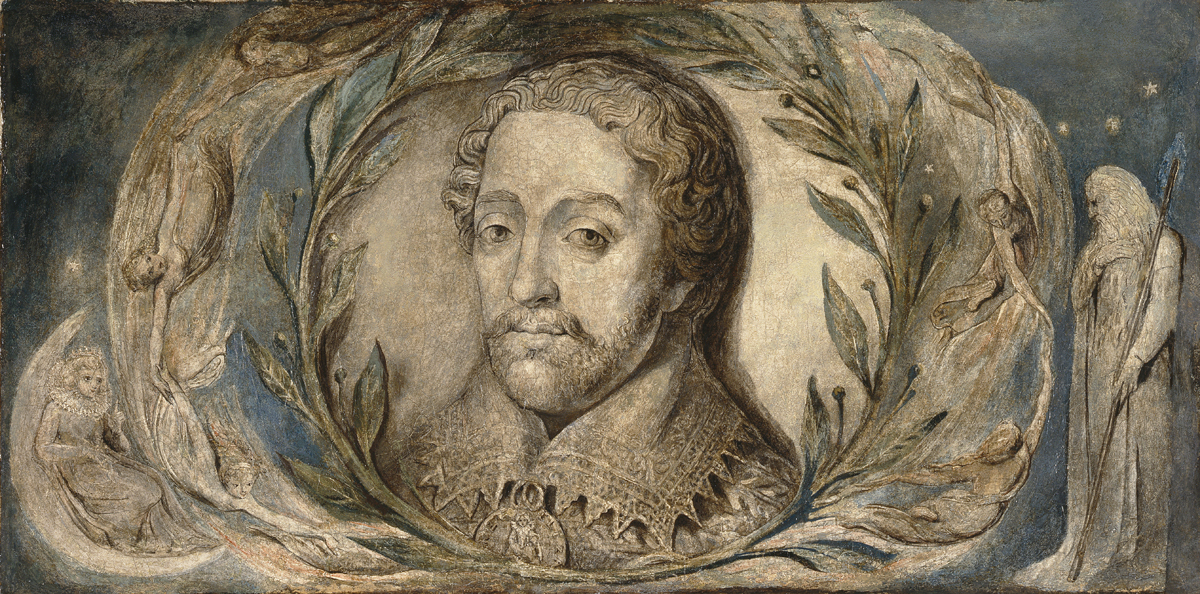William Blake, Edmund Spenser, c. 1800
Source: Wiimedia Commons
In Book IV, Canto XI of The Faerie Queene (1596), Edmund Spenser describes the marriage of Thames and Medway. I won't attempt to describe here how this fits into the plot, but it takes place in Proteus's house and the guests include many gods of seas and rivers. Among these are Nile, Rhine, Ganges, Amazon and 'rich Oranochy, though but knowen late' (Spenser's friend Raleigh had explored the Orinoco a year earlier, hoping to find El Dorado). English rivers are of course invited, but so too are the rivers of Ireland, where Spenser was living at the time. Incidentally, there are occasional brief references to the Irish landscape in other parts of The Faerie Queene, e.g. the River Shannon (Shenan) whose battle with the ocean tide is a simile for the struggle between two knights (and perhaps the unequal struggle between Ireland and England too). I have written here before about Spenser and Ireland and it is not really surprising that this wedding encompasses the Irish rivers, for 'why should they not likewise in loue agree'.
Thames, the bridegroom, arrives with his elderly parents Thame and Isis to the accompaniment of a harp played by Arion. His bride arrives later with handmaids and sea nymphs. I will quote here just one stanza, which comes as Thames processes in, dressed in a light blue robe and wearing a coronet in the shape of London. Various tributaries to the Thames are mentioned, including the one nearest to where I live, the Lee.
I love that description of the Lee. It would make a good quiz to match the epithet to the river in this Canto - stately Severn, storming Humber, speedy Tamar - or guess it from a brief description 'decked all with Woods / Like a Wood-God, and flowing fast to Rhy' (the River Rother). In real life the Thames and Medway meet and merge at Rochester, where Spenser had worked as secretary to the Bishop in 1589. A year later he mentioned in a letter a poem he was working on, now lost, called Epithalamion Thamesis, which prefigured this section of The Faerie Queene. There was also a model for this Canto in another river-wedding poem, De Connubio Tamae et Isis, fragments of which appear in William Camden's great topographical work Britannia (1586). In Camden, Isis is the male god, who comes from a cave in the Cotswolds to meet his bride, Tame, at Dorchester in Oxfordshire, where they retire to the nuptial chamber. After the celebration they rise as one, Thamisis, and make their way downriver, past Windsor, Runnymede, Hampton Court and Richmond, towards the sea.And round about him many a pretty Page
Attended duly, ready to obey;
All little Rivers, which owe Vassalage
To him, as to their Lord, and Tribute pay;
The chaulky Kenet, and the Thetis grey,
The morish Cole, and the soft-sliding Brean,
The wanton Lee, that oft doth lose his way,
And the still Darent, in whose Waters clean
Ten thousand Fishes play, and deck his pleasant Stream.
Are there earlier examples of river-marriage poems? In a an article on the subject ('Spenser, Camden, and the Poetic Marriages of Rivers', Studies in Philology, 1967), Jack B. Oruch notes that the Italian humanist Giovanni Pontano wrote a 'topographical pageant' into his poem Lepidina (1496), in which Sebeto, a river god, marries the patron divinity of Naples. As for later writers, there is Michael Drayton, whose Poly-Olbion I have mentioned here before - his Fifteenth Song (1612) takes up again the theme of the marriage of Thame and Isis. The rivers Walla and Tavy are wed in Britannia's Pastorals (1616) by a friend of Drayton's, William Browne of Tavistock. Browne may also be the author of an anonymous poem in which the Torridge marries the Ock. And there is a 1613 masque by Francis Beaumont in which the Thames marries the Rhine, part of the celebrations for the wedding of Princess Elizabeth (later called The Winter Queen) and Frederick V.
J. M. W. Turner, Union of the Thames and Isis ('Dorchester Mead, Oxfordshire), 1808
Source: Wiimedia Commons
The poetic tradition seems to have faded out in the early seventeenth century. In 1808 Turner exhibited a painting entitled the Union of the Thames and Isis, but this is not one of his mythological paintings. Instead of Camden's magnificent bridal chamber, prepared for Tame by Grace, Concord, Hymen and the Naiads, we have a view of cows standing in brown water. The Tate's curators describe this quiet landscape: 'The Thame, hardly more than a stream, is in the foreground while the Thames [Isis] is glimpsed beyond the wooden bridge on the right. Modest and direct, the picture also evokes the seventeenth-century painter Aelbert Cuyp in its lighting and pastoral imagery.' Two more centuries on, it is hard to imagine a return to the extravagant topological wedding feasts of Spenser's time, though it would be fun to write one in which the river gods make small talk over glasses of fizz, watch the bride and groom trying not to giggle, sit through an inappropriate best man's speech and end up the dancing drunkenly to Abba on a slippery dance floor.

_-_Google_Art_Project.jpg/797px-Joseph_Mallord_William_Turner_-_Union_of_the_Thames_and_Isis_('Dorchester_Mead%2C_Oxfordshire)_-_Google_Art_Project.jpg)

